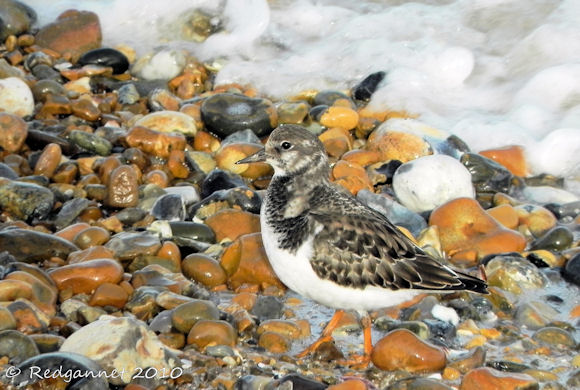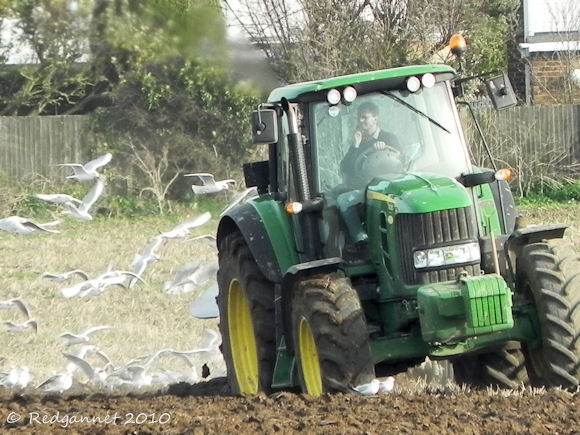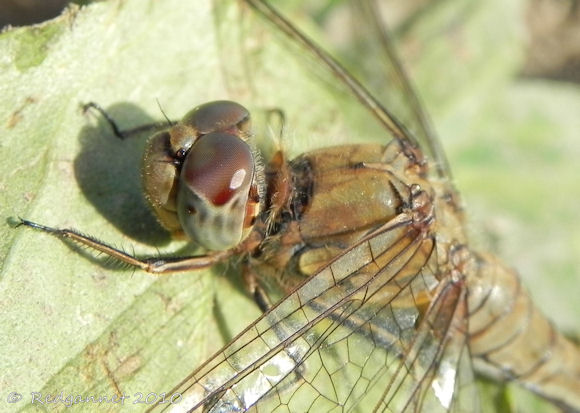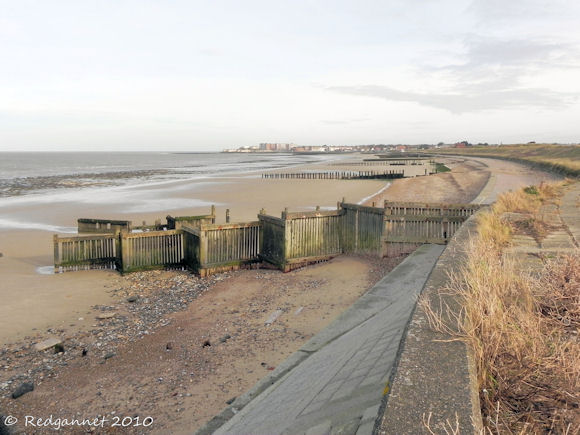From the Minnis Pub on the southern (Kent) shore of the Thames Estuary (Google Earth ref; 51° 22’ 46”N, 1°16’ 52”E), I was looking west and could see the towers of the ruined, 12th Century church of St Mary’s at Reculver (51°22’46”N, 1°11’58”E).
It is a bit further than this picture might suggest. As the crow flies it is about 3.5 miles or 5.75 kms. Any crow would have had its work cut out today though as there was a strong wind blowing. Even the Black-headed Gulls were struggling to appear graceful and elegant in flight. Confused doggies ran in circles as balls, thrown for them, were returned to the throwers by the stiff south westerly.
Occasionally, events conspire to give me a chance to bird in my own backyard. As I spend so much time working away from home, I try to devote as much attention to my family as I can when I get back, but in the absence of copious presents, they tire of this attention very quickly. This week I have a few extra days off and their patience is wearing thin, so I took myself off to look for Snow Buntings.These birds are one of the rarest breeding birds in the UK, though they are widespread on the East Coast during the winter. They are a scarce, but regular feature of the shingle beaches of the estuary and have been recorded at Reculver each year from October onwards since Christopher Hindle started documenting bird sightings there in 1963 . His diary on the Kent Ornithological Society website http://www.kentos.org.uk/Reculver/Reculver.htm showed that they had arrived for the season and my wife was making a comparison between the tidiness of the house when I am at home and when I am away. So in order to contribute as best I could to domestic bliss, I went out.
The tide was just beginning to recede as I arrived. This was more coincidence than contrivance, but it suited me well as the shorebirds were pushed closer to the sea wall and the Ruddy Turnstones made easy pickings for my new camera. I bought a Nikon P100 to use while my big lens is being repaired and it has produced a few nice pictures already. I don’t enjoy using it as much as a DSLR, but it has impressed me.
The buffeting wind made photography difficult. It came whistling across the levels and hit the raised dyke with full force. I would have had a lot of very shaky pictures with the DSLR, but the stabilising technology in the bridge-type Nikon coped very well. I walked with the water on my right. The turnstones were the first onto the wet shingle as the tide retreated, though some were still roosting on a breakwater.
On my left, a freshly ploughed field proved irresistible to Northern Lapwings, Starlings and Black-headed Gulls.The sea wall runs fairly straight and parallel to the water. It meanders gently on a couple of occasions as it skirts Plumpudding Island and Coldharbour Lagoon.
The raised walkway and shingle banks provided lea shelter for roosting Oystercatchers, Grey Plovers, Sanderling and a couple of Ringed Plovers. The wind carried the sound of bird scarers from the flat fields inland and had the required effect of putting all the waders to flight from the beach. I took a few shots with the camera and was surprised to find that I could recognise the birds when I downloaded the card later on.The digital zoom facility wasn’t able to do justice to the Common Redshanks of Coldharbour Lagoon, but when the wind was trying to push me in with them, it wasn’t a bad effort.
I turned inland from here and followed the River Wantsum upstream. At the railway line I turned left and sauntered slowly through thorn trees laden with dark red berries. I lingered in the area in the hope that some of the reported influx of Bohemian Waxwings might put in an appearance. Instead a late Common Darter got the treatment from the Nikon’s macro facility. This individual is a female which has turned brown indicating great age. In order to get close to the dragonfly, I had to lie down on to the ground which prompted a concerned birder to come to check that I was OK. He told me that Snow Buntings had been seen that morning on the beach just beyond where I had turned inland.Waxwings, Snow Buntings. Snow Buntings, Waxwings. Decisions decisions. Either bird would be a lifer, but I plumped for the bunting due to its here and nowness. There is a Tesco superstore close to our house. It has a big car park full of rowan trees, so the Waxwings can come to me.
The buntings feed on seeds from coarse grasses that grow in sand dunes and coastal habitats. Finding a brown, grey and white bird on the brown, grey and white shingle wouldn’t be easy, but they are restless feeders which I was hoping would make them stand out.Perhaps like the rest of the birds today, they were keeping their heads down out of the wind. The hoped for flashes of white from the extended wings never materialised despite a good look through the mixed grass and shingle areas. They are very confiding birds I believe and don’t flush quickly. Therefore if they were sitting still and staying put, the chances of outwitting their camouflage were low.
Soon it was time to go home and mess up the house again, but not before a Peregrine swept across the seawall and down into Coldharbour Lagoon. The redshank scattered and like a sweet wrapper from a fast car’s window, were caught up and swept away by the wind as they cleared the shelter offered by the raised road. The falcon dipped back behind the wall and was gone. Earlier, one had been reported putting a Hooded Crow, a recent rarity, to flight as it hunted further along.
I was heading back to my car when a small flock of birds caught my eye. They were travelling east to west across the water, about 5 meters beyond the small breakers. It struck me immediately that these were not wading birds. The undulating flight and white inner panels in the wings of 3 of the birds left me with only one choice; Snow Buntings. It was not possible to get a photograph, but I intend to return and get one.
Christopher has kindly given me the text of a booklet that he prepared for self-guided walks around the Reculver Marshes. It is reproduced below and remains the copyright of Christopher Hindle.
Bird Species; 28
Great Cormorant 35, Little Egret 1, Brent Goose 32, Common Kestrel 2, Peregrine Falcon 1, Eurasian Oystercatcher 120, Northern Lapwing 45, Grey Plover 60, Ringed Plover 2, European Curlew 3, Common Redshank 14, Ruddy Turnstone 60, Sanderling 40, Common Gull 6, Herring Gull 40, Black-headed Gull 400, Stock Dove 30, Common Wood Pigeon 15, Eurasian Collared Dove 4, Meadow Pipit 9, Pied Wagtail 15, Common Blackbird 2, Eurasian Magpie 2, Rook 4, Carrion Crow 30, Common Starling 150, Chaffinch 35, Snow Bunting 8
RECULVER by kind permission of Christopher Hindle.
Reculver Country Park lies on the N.E. coast of Kent, 2 miles east of Herne Bay. The main landmark at Reculver is Reculver Towers, the remains of a twelfth century monastic church, which itself is situated on top of a Roman Fort. West of the Towers are the low eroding cliffs at Bishopstone and east is the seawall which stretches to Minnis Bay. Behind this seawall are Reculver Marshes which are now given over almost exclusively to agriculture.
Reculver is particularly good at migration times - April and May, and August to October - when almost anything can turn up in the right weather conditions. Reculver can be particularly rewarding in winter when one can get excellent views of the regular flock of Brent Geese, together with good numbers of waders on the beach. Here it is also possible to see Snow Buntings and even occasionally Shorelarks. In summer Ringed Plovers breed on the shingle, and on the land behind the seawall birds such as Reed and Sedge Warblers and Yellow Wagtails, Meadow Pipits and Reed Buntings breed.
ACCESS
BY ROAD - Leave the A299 (Thanet Way) east of Herne Bay at the turn off marked Reculver. From here it is a mile and a half to the car park below Reculver Towers (TR225694).
NEAREST TRAIN STATION - Herne Bay
BUS - A half hourly bus service runs from Herne Bay to Reculver - for further details phone Stagecoach - 01227-472082.
FACILITIES
TOILETS - Reculver Country Park Centre and King Ethelbert Public House.
REFRESHMENTS - The King Ethelbert Public House, and a cafe near the telephone box is open during the summer months.
INFORMATION - visit the Reculver Country Park Centre beside the car park to get information and leaflets. There are also information display boards at the entrance to the car park and at Reculver Towers.
TIMING - Allow 2-3 hours for the complete circular walk. It is not often hot at Reculver!
Be prepared to wrap up warm, particularly in winter when a wind off the sea can make it feel significantly colder than inland. A start before 9.00am or in the late afternoon will probably produce the largest variety of species.
1. Reculver Car Park.
Looking west from the car park at low tide during the winter you may see groups of Brent Geese(W) feeding at the waters edge below the coastguard lookout at Bishopstone. In the summer months Fulmars(S) regularly patrol these cliffs, which hold Kent’s largest Sand Martin(S) colony - Stock Doves(R) also nest on these cliffs.
Now walk from the car park sea wall up the path towards Reculver Towers.
2. Reculver Towers
If it is windy Reculver Towers can provide a sheltered place to watch birds flying past, often quite close inshore. In spring and autumn Common(SM), Sandwich(SM) and Little Terns(SM) may be seen, whilst in winter you are more likely to see Red-throated Divers(W), ducks(W), Brent Geese(W) and various species of gull. The grassy areas and walls of the Roman Fort also attract migrants, particularly in autumn. Look out for Yellow Wagtails(SM) on the grass and Pied Flycatchers(M), Redstarts(M), Willow Warblers(M) and Chiffchaffs(M) around the walls.
From the Towers the footpath leads down and left to the seawall. From here walk east a short distance and through the gate to view the Oyster Farm and its pools.
3. Oyster Farm
The extensive pools associated with the Oyster Farm often attract waders such as Redshank(R), Greenshank(M) and Common Sandpiper(M), and in cold weather in winter, ducks such as Red-breasted Merganser(W) and Goldeneye(W) and the occasional grebe(W) can be seen. Also keep your eyes open for Kingfisher(R) and Rock Pipit(WM) in this area.
Now walk east along the seawall.
4. Seawall
Walking along the seawall towards Cold Harbour will turn up a variety of wading birds. If the tide is low, look particularly at the mussel beds where you can see Oystercatcher (RW), Redshank(R), Turnstone(W), Ringed Plover(R), Curlew(W), Grey Plover(W) and Dunlin(W). Sanderling(W) can often be seen running about like clockwork toys feeding near the water’s edge. If the tide is in, keep your eyes open on the sea and watch for passing Cormorants(R) and waders, or Little Terns(S) feeding off shore. On the seawall itself you may see Wheatears(SM) and Yellow Wagtails(SM) in summer and Reed(R) and Snow Buntings(W) in winter. If you are lucky enough to choose the right day in September or October you may witness the migration of thousands of Swallows(S) and Sand(S) and House Martins(S) as they fly along the seawall. The shingle on the seaward side of the wall is the best place in the area to see Shorelarks(W) in the winters when they arrive in Kent. The fields inland regularly hold up to 500 Brent Geese(W) in winter, together with Mallard(R), Teal(W), Wigeon(W) and a large flock of Mute Swans(R). Frequently look out to the embankment, known as the Green Wall, which runs parallel to the seawall as Hen Harriers(W) and occasionally Short-eared Owls(W) hunt up and down it.
The walk from the Oyster Farm to Cold Harbour is about one and a half miles and will take 30-40 minutes.
5. Cold Harbour Lagoon
The lagoon itself is used throughout the year by birds. Look for Redshank(R), Turnstone(W), Dunlin(W) and Shelduck(R). Meadow Pipits(R), Reed Buntings(R), Skylarks(R)and Greenfinches(R) feed in the small patch of saltmarsh. Over the shingle ridge there is normally a large high tide roost of waders, on occasions numbering over a thousand birds - Turnstone(W), Sanderling(W), Oystercatcher(RW), Grey Plover(W), Redshank(R), Dunlin(W) and the occasional Curlew(W), Bar-tailed Godwit(W) or Purple Sandpiper(W). PLEASE DO NOT DISTURB SLEEPING BIRDS, BUT WATCH THEM FROM A DISTANCE . There are usually duck sitting on the sea off Cold Harbour- Eider(R), Common Scoter(M), Wigeon(W) and Mallard(R). In the past Little Terns(S) bred on this shingle bank, but now too much disturbance means that birds seen here are usually non-breeders or migrating birds.
From the seawall behind the lagoon a footpath runs south beside the River Wantsum towards the railway line.
6. River Wantsum
This narrow river is the western limit of the Isle of Thanet and you may see Mute Swan(R), Heron(R) or Moorhen(R) here. The reeds and scrub at its edge have breeding Reed(S) and Sedge Warblers(S), and if you are lucky you may hear a Grasshopper Warbler(S) living up to its name. In really cold winters when inland waters freeze the River can attract duck and grebes. In recent years these have included Smew(W), Goldeneye(W) and Slavonian Grebe(W).
Continue down this path, up the railway embankment and over the railway crossing to walk along beside the Chambers Wall bushes.
7. Chambers Wall Bushes
This line of bushes, adjacent scrub and reeds has breeding Whitethroat(S), Lesser Whitethroat(S), Linnet(RM), Goldfinch(RM) and Yellowhammer(R) and also acts as a magnet to migrating birds - almost anything can turn up here! Early mornings and evenings are the best time to see migrants. Look out for Fieldfare(W) and Redwing(W) flying in from Scandinavia in the autumn, and in spring and autumn you will see various warblers(M), flycatchers(M) and chats(M).
When you reach the small, fishermen’s car park return back down the path, but after 100 yards take the left fork across a bridge and walk to the railway embankment and Green Wall.
8. Railway Embankment and Green Wall
The bushes besides the railway attract birds such as Whitethroat(S), Whinchat(SM) and Reed(S) and Sedge Warblers(S). Hen Harrier(W), Merlin(W), Kestrel(R) and Short-eared Owl(W) can often be seen hunting over the marsh. This whole area is on the flight path of large numbers of winter and summer visitors, and depending on when you visit you may see Chaffinches(M), Bramblings(M), Meadow Pipits(RM), Fieldfares(W), Redwings(W), Lapwings(WM) and Swallows(S) and martins(S) moving through, usually flying west.
Walk westwards along the railway embankment until it heads towards the sea then follow the Green Wall all the way back to Reculver.
RECULVER SEAWALL, BEACH AND BIRDS
The shingle beach between Reculver and Minnis Bay forms a feeding and roosting place for many birds, and also a breeding place for Ringed Plovers. At low tide a variety of waders feed on the sand, mud and mussel beds. The lagoon at Cold Harbour still has a remnant area of salt marsh with its associated plants. During the summer and autumn the seawall attracts many insects from the surrounding farmland, which in turn attracts insect eating birds like wagtails, pipits, wheatears and whinchats.
BRENT GEESE are winter visitors from their breeding grounds in northern Russia. Historically they were much rarer than they are today, but in the last twenty years, they have learnt to eat winter wheat, barley and oil seed rape and their numbers have increased dramatically.
HEN HARRIERS frequently visit the marsh during the winter months. Look out for their slow flight and V-shaped wings as they hunt over the marsh. Females and immatures are brown with white rumps whilst males are pale grey with black wing tips.
OYSTERCATCHERS are mainly winter visitors, but the odd pair breeds on the beach or on the agricultural land behind the seawall. Large numbers roost at Cold Harbour at high tide and feed on the mussel beds at low tide. They are very obvious and noisy birds.
RINGED PLOVERS are present all year and are regular breeders on the shingle beach. The eggs and young are wonderfully camouflaged against the shingle and virtually impossible to see. Watch out for their display flight and calling during late spring and summer, but please do not disturb them.
TURNSTONES are mainly winter visitor, but a few non-breeders stay all summer. This species lives up to its name, turning over stones to eat sand shrimps and other creatures. A common bird on Reculver beach with a large roost at Cold Harbour at high tide.
LITTLE TERNS used to breed at Reculver with as many as 36 pairs in the 1970’s, however increased recreational use of the beach between Reculver and Minnis Bay means the species has not bred for some time. It is however still regularly seen off Reculver during the summer months.
SHORELARKS are rare birds and a Reculver speciality although they are not seen in every year. In winters when they do arrive in Kent, there favourite place at Reculver is on the beach between the Green Wall and Cold Harbour.
YELLOW WAGTAILS are summer visitors from Africa and nest on the agricultural land south of the seawall. During August large numbers of migrant Yellow Wagtails feed on insects on the seawall. They have an elongated appearance and a very distinctive call note - “tsweep.”
SNOW BUNTINGS visit Reculver in most winters and can often be seen feeding on the beach above high water mark. When a group takes off listen for their call note “teu” and look out for the large white flashes on their wings. Adult males are particularly pale and attractive birds.







No comments:
Post a Comment